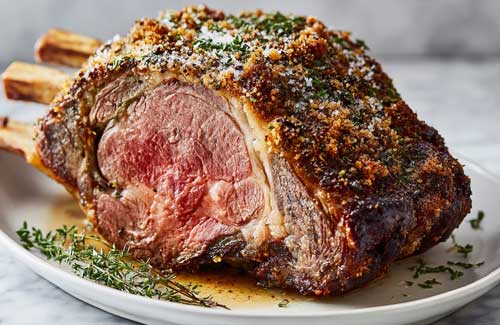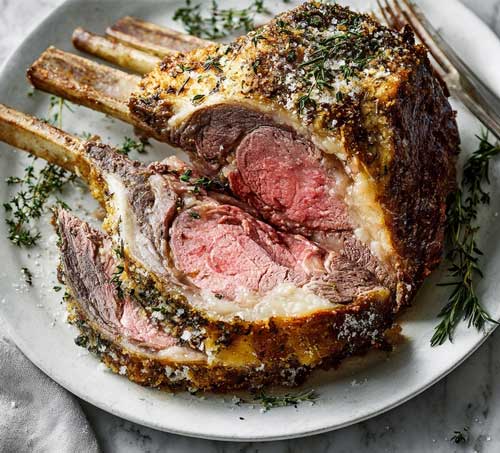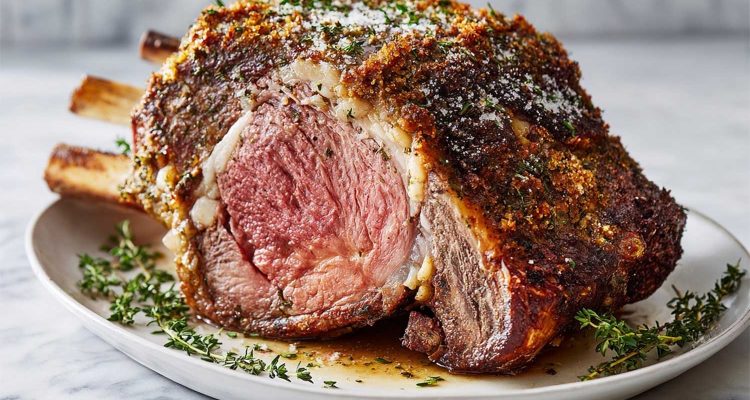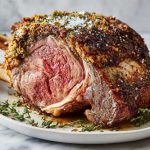There are some dishes that feel like a celebration the moment they hit the table. A rib roast cooked under a salt crust is one of those. It looks dramatic, tastes bold, and makes everyone believe you’ve spent half your life training in a French kitchen, when in truth the process is almost foolproof. Even better, it’s keto-friendly, loaded with fat, and needs hardly any fancy ingredients.
This recipe is my go-to for holidays, birthdays, or just when I want to spoil myself and maybe show off a little. The secret is in that thick crust of salt that locks in all the juices while the outside turns into a golden crackling coat you can hear snap when you cut it.
Let’s break down exactly how to make it, step by step, and why each step matters.
Why Rib Roast Works So Well
Rib roast, sometimes called prime rib when you’re lucky enough to get it from the best cut, comes from the rib section of the cow. That means marbling. Fat running through the meat keeps it moist even with long roasting times. And on keto, fat is not your enemy—it’s your friend. This roast checks all the boxes: flavor, satiety, and that “I’m eating like a king” feeling.
I remember the first time I tried it with a salt crust. I had friends over, and one of them was skeptical: “You’re going to bury that expensive roast in salt? Isn’t that insane?” But when the crust cracked open and the steam rushed out smelling like beef heaven, he went silent. Then he went back for seconds.
That’s the magic here. Salt crust sounds intimidating but it’s one of the easiest tricks you’ll ever learn.
What You’ll Need
Keep it simple. Don’t overthink it. You don’t need dozens of spices or marinades. The salt crust does the heavy lifting.
Ingredients:
- 1 whole beef rib roast (4–6 pounds works beautifully)
- 4 cups kosher salt (yes, that much)
- 3 egg whites
- 1/2 cup water
- 2 tablespoons black pepper, freshly cracked
- 3–4 cloves garlic, minced
- 2 tablespoons fresh rosemary (or thyme if you prefer)
- 2 tablespoons olive oil
That’s it. Notice what’s missing? Sugar, bread crumbs, anything starchy. The keto rule is respected all the way through.
Why Kosher Salt, Not Table Salt
This part matters. Regular table salt is too fine and harsh; it’ll make the crust too tight and overwhelming. Kosher salt, with its coarse grains, builds a shell without over-salting the meat. Think of it like using bricks instead of sand—you need structure.
Keto Crackling Rib Roast (Salt Crust Step by Step Method)

Prepping the Roast
- Bring it to room temp – Take the rib roast out of the fridge at least one hour before cooking. Cold meat cooks unevenly.
- Season the roast itself – Rub olive oil over the meat, then press in garlic, rosemary, and black pepper. The salt crust won’t season the inside of the roast much; this is your chance to add flavor where it counts.
- Tie it up (optional) – If your roast has loose flaps or isn’t a neat cylinder, tie it with kitchen twine. This makes slicing later much easier.
Mixing the Salt Crust
Here’s the fun part. In a big bowl, mix the kosher salt with egg whites and water. Stir until it feels like damp sand—the kind that packs into a sandcastle at the beach. Not soupy, not dry. When you squeeze it in your hand, it should clump.
That’s your edible concrete.
Building the Shell
- Line a baking sheet with parchment paper.
- Spread a thin layer of the salt mixture on the sheet to act as the base.
- Place the roast on top.
- Pack the rest of the salt mix around the meat, pressing firmly until it’s completely covered. Leave no gaps. The entire roast should look like a white dome.
I always get a kick out of this step. It looks ridiculous—like you’re wrapping a gift in gravel—but it works like nothing else.
Roasting
Heat the oven to 450°F (230°C). Put the roast in for 20 minutes to set the crust and get that Maillard reaction started. Then lower the heat to 325°F (165°C) and keep roasting.
Time depends on size, but here’s a rough guide:
- Medium-rare: 15–17 minutes per pound
- Medium: 18–20 minutes per pound
Don’t just guess. Use a meat thermometer. Aim for:
- 120–125°F (49–52°C) for rare
- 130–135°F (54–57°C) for medium-rare
- 140–145°F (60–63°C) for medium
Remember, the meat keeps cooking as it rests.
Cracking the Crust
Once you hit your target temp, pull the roast out and let it rest for 15–20 minutes. Don’t cheat on this part. Resting allows juices to redistribute. Cut too soon and you’ll lose them all on the cutting board.
Now grab the back of a heavy spoon or the flat side of a knife and gently whack the crust. It’ll split open like cracking clay. Peel it off in chunks. Inside you’ll find the most gorgeous, steaming roast.
Carving and Serving
Slice against the grain into thick slabs. Some people like it paper-thin, but with rib roast, I say go bold. Half-inch slices show off that pink center with the browned edges.
On keto, you don’t need mashed potatoes or Yorkshire pudding. Serve it with creamed spinach, roasted Brussels sprouts, or cauliflower mash if you want something hearty. I personally like it plain with just a drizzle of pan drippings.
Why Salt Crust Beats Regular Roasting

A lot of folks just season the outside and throw the roast in the oven. That works, but here’s why the salt crust wins:
- Moisture lock – The crust traps steam, almost like cooking inside a clay pot. The meat bastes itself.
- Even cooking – Salt distributes heat, so no dry patches.
- Drama – Breaking open the crust is an event. It feels primal and fancy at the same time.
The meat doesn’t turn salty. People are always surprised by that. The crust protects, but it doesn’t soak the meat like a brine would.
Keto Benefits
This dish is practically built for keto:
- High fat content keeps you full for hours.
- No carbs, no sugar sneaking in.
- Protein quality is excellent.
I’ve eaten this roast before a long hike and gone half the day without feeling hungry. That’s the power of fat plus protein.
Leftovers
If by some miracle you have leftovers, rib roast keeps beautifully. Slice it and store in an airtight container.
Ideas for next-day meals:
- Pan-seared rib slices with eggs for breakfast
- Keto beef salad with arugula and avocado
- Lettuce-wrapped roast beef “sandwiches” with mayo and horseradish
Sometimes the leftovers are almost better than the main event because the flavors deepen overnight.
A Few Tips from Experience
- Don’t skimp on the thermometer. Eye-balling doneness is risky, and rib roast is too pricey to gamble.
- Add herbs under the crust, not in it. Herbs in the salt crust just burn. Always season the meat itself.
- Let the roast shine. You don’t need complicated sauces. A touch of horseradish cream or jus from the pan is enough.
The First Time I Served This
Quick story—my family has a tradition of ham on Christmas. One year I showed up with this salt-crusted rib roast instead. My uncle frowned at me like I’d broken some sacred rule. “Where’s the ham?” he asked. I told him to wait.
When I cracked open the crust, the entire table leaned in. The smell hit first. Then the juices pooled as I sliced, and suddenly no one remembered ham existed. We never went back. That roast became the new tradition.
Food has that power—it rewrites memories.
Why It Works on Pinterest
People love food that looks dramatic in pictures. A rib roast under salt crust is Instagram-worthy without filters. That cracked dome, the steam, the perfect pink slices—those images pull people in. But the method itself is so easy that home cooks can actually pull it off, which is why it gets shared again and again.
Nutritional Breakdown (Approx, per serving 6oz)
- Calories: 420
- Fat: 32g
- Protein: 30g
- Carbs: 0g
Perfectly in line with keto macros.
Conclusion
Cooking a rib roast under a salt crust might sound like something only chefs do, but it’s honestly one of the most forgiving methods you’ll ever try. If you’re living keto, it ticks every box: rich fat, zero carbs, maximum satisfaction. If you’re not keto, it still feels like the most luxurious centerpiece you can bring to a table.
Every time I serve it, people talk. They ask about the technique, they remember the flavor, and they want the recipe. That’s how you know you’ve cooked something worth keeping in your rotation.
So next holiday, birthday, or just a random Saturday when you want to treat yourself, give this roast a go. The salt may look strange at first, but once you hear that crust crack, you’ll never roast beef the old way again.
PrintKeto Crackling Rib Roast (Salt Crust Method)
A juicy keto rib roast cooked in a salt crust for the perfect golden crackling outside and tender beef inside. Easy method, stunning results, and zero carbs.
- Prep Time: 20 minutes
- Cook Time: 1 hour 30 minutes (approx, depends on roast size)
- Total Time: 1 hour 50 minutes
- Yield: 8 servings 1x
- Category: Main Course, Dinner
- Method: Roasting
- Cuisine: American, Keto, Low-Carb
Ingredients
-
1 beef rib roast (4–6 pounds)
-
4 cups kosher salt
-
3 egg whites
-
1/2 cup water
-
2 tablespoons black pepper, freshly cracked
-
3–4 cloves garlic, minced
-
2 tablespoons fresh rosemary (or thyme)
-
2 tablespoons olive oil
Instructions
-
Preheat oven to 450°F (230°C).
-
Let rib roast rest at room temperature for 1 hour.
-
Rub olive oil, garlic, rosemary, and black pepper over roast. Tie with kitchen twine if needed.
-
Mix kosher salt, egg whites, and water in a bowl until texture is like damp sand.
-
Line a baking sheet with parchment paper. Spread a thin layer of salt mixture as the base.
-
Place roast on top and pack remaining salt mixture all around to form a crust with no gaps.
-
Roast at 450°F (230°C) for 20 minutes. Lower oven to 325°F (165°C) and cook until internal temp reaches 120–125°F for rare, 130–135°F for medium-rare, or 140–145°F for medium.
-
Remove from oven and rest 15–20 minutes.
-
Crack open salt crust, peel away, and slice against the grain.
Notes
-
Always use kosher salt, not table salt.
-
Use a meat thermometer for best results.
-
Serve with keto sides like cauliflower mash or creamed spinach.
-
Leftovers taste great with eggs, in salads, or lettuce wraps.
Nutrition
- Serving Size: 1 serving (6 oz)
- Calories: 420 Sugar: 0g Sodium: varies (crust removed, meat lightly salted) Fat: 32g Saturated Fat: 12g Unsaturated Fat: 18g Trans Fat: 1g Carbohydrates: 0g Fiber: 0g Protein: 30g Cholesterol: 120mg
Frequently Asked Questions (FAQs)
Does the salt make the rib roast too salty?
No. The salt crust protects the meat while it cooks but doesn’t soak into the beef. The roast comes out seasoned but not overly salty. The crust is cracked and removed before serving.
How do I know when the rib roast is done?
Use a meat thermometer for accuracy. For medium-rare, take it out at 130–135°F. For medium, 140–145°F. Always rest the roast for at least 15 minutes before slicing.
What size rib roast should I buy?
Plan about 1 pound of bone-in rib roast per person, or 3/4 pound if you have a lot of side dishes. A 4–6 pound roast usually feeds 6–8 people.

